Aida Nematzadeh
Imagen 3
Aug 13, 2024Abstract:We introduce Imagen 3, a latent diffusion model that generates high quality images from text prompts. We describe our quality and responsibility evaluations. Imagen 3 is preferred over other state-of-the-art (SOTA) models at the time of evaluation. In addition, we discuss issues around safety and representation, as well as methods we used to minimize the potential harm of our models.
Evaluating Numerical Reasoning in Text-to-Image Models
Jun 20, 2024



Abstract:Text-to-image generative models are capable of producing high-quality images that often faithfully depict concepts described using natural language. In this work, we comprehensively evaluate a range of text-to-image models on numerical reasoning tasks of varying difficulty, and show that even the most advanced models have only rudimentary numerical skills. Specifically, their ability to correctly generate an exact number of objects in an image is limited to small numbers, it is highly dependent on the context the number term appears in, and it deteriorates quickly with each successive number. We also demonstrate that models have poor understanding of linguistic quantifiers (such as "a few" or "as many as"), the concept of zero, and struggle with more advanced concepts such as partial quantities and fractional representations. We bundle prompts, generated images and human annotations into GeckoNum, a novel benchmark for evaluation of numerical reasoning.
Revisiting Text-to-Image Evaluation with Gecko: On Metrics, Prompts, and Human Ratings
Apr 25, 2024Abstract:While text-to-image (T2I) generative models have become ubiquitous, they do not necessarily generate images that align with a given prompt. While previous work has evaluated T2I alignment by proposing metrics, benchmarks, and templates for collecting human judgements, the quality of these components is not systematically measured. Human-rated prompt sets are generally small and the reliability of the ratings -- and thereby the prompt set used to compare models -- is not evaluated. We address this gap by performing an extensive study evaluating auto-eval metrics and human templates. We provide three main contributions: (1) We introduce a comprehensive skills-based benchmark that can discriminate models across different human templates. This skills-based benchmark categorises prompts into sub-skills, allowing a practitioner to pinpoint not only which skills are challenging, but at what level of complexity a skill becomes challenging. (2) We gather human ratings across four templates and four T2I models for a total of >100K annotations. This allows us to understand where differences arise due to inherent ambiguity in the prompt and where they arise due to differences in metric and model quality. (3) Finally, we introduce a new QA-based auto-eval metric that is better correlated with human ratings than existing metrics for our new dataset, across different human templates, and on TIFA160.
How FaR Are Large Language Models From Agents with Theory-of-Mind?
Oct 04, 2023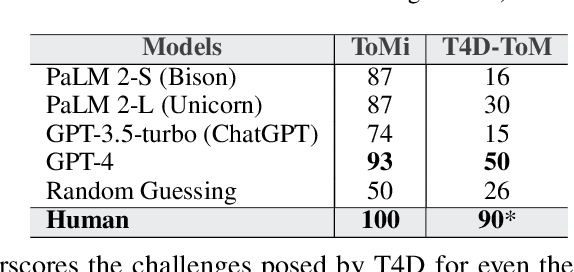
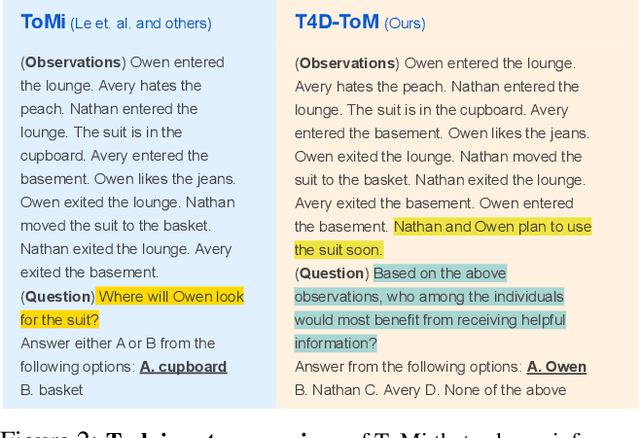

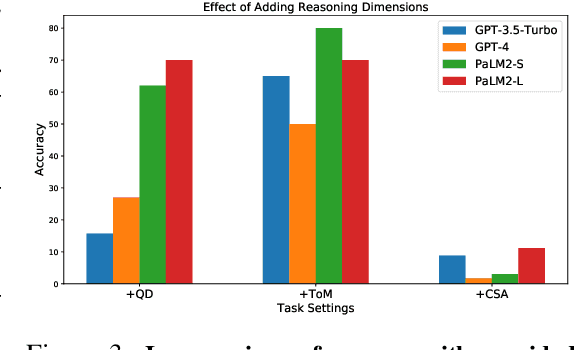
Abstract:"Thinking is for Doing." Humans can infer other people's mental states from observations--an ability called Theory-of-Mind (ToM)--and subsequently act pragmatically on those inferences. Existing question answering benchmarks such as ToMi ask models questions to make inferences about beliefs of characters in a story, but do not test whether models can then use these inferences to guide their actions. We propose a new evaluation paradigm for large language models (LLMs): Thinking for Doing (T4D), which requires models to connect inferences about others' mental states to actions in social scenarios. Experiments on T4D demonstrate that LLMs such as GPT-4 and PaLM 2 seemingly excel at tracking characters' beliefs in stories, but they struggle to translate this capability into strategic action. Our analysis reveals the core challenge for LLMs lies in identifying the implicit inferences about mental states without being explicitly asked about as in ToMi, that lead to choosing the correct action in T4D. To bridge this gap, we introduce a zero-shot prompting framework, Foresee and Reflect (FaR), which provides a reasoning structure that encourages LLMs to anticipate future challenges and reason about potential actions. FaR boosts GPT-4's performance from 50% to 71% on T4D, outperforming other prompting methods such as Chain-of-Thought and Self-Ask. Moreover, FaR generalizes to diverse out-of-distribution story structures and scenarios that also require ToM inferences to choose an action, consistently outperforming other methods including few-shot in-context learning.
Weakly-Supervised Learning of Visual Relations in Multimodal Pretraining
May 23, 2023Abstract:Recent work in vision-and-language pretraining has investigated supervised signals from object detection data to learn better, fine-grained multimodal representations. In this work, we take a step further and explore how we add supervision from small-scale visual relation data. In particular, we propose two pretraining approaches to contextualise visual entities in a multimodal setup. With verbalised scene graphs, we transform visual relation triplets into structured captions, and treat them as additional views of images. With masked relation prediction, we further encourage relating entities from visually masked contexts. When applied to strong baselines pretrained on large amounts of Web data, zero-shot evaluations on both coarse-grained and fine-grained tasks show the efficacy of our methods in learning multimodal representations from weakly-supervised relations data.
Measuring Progress in Fine-grained Vision-and-Language Understanding
May 12, 2023Abstract:While pretraining on large-scale image-text data from the Web has facilitated rapid progress on many vision-and-language (V&L) tasks, recent work has demonstrated that pretrained models lack "fine-grained" understanding, such as the ability to recognise relationships, verbs, and numbers in images. This has resulted in an increased interest in the community to either develop new benchmarks or models for such capabilities. To better understand and quantify progress in this direction, we investigate four competitive V&L models on four fine-grained benchmarks. Through our analysis, we find that X-VLM (Zeng et al., 2022) consistently outperforms other baselines, and that modelling innovations can impact performance more than scaling Web data, which even degrades performance sometimes. Through a deeper investigation of X-VLM, we highlight the importance of both novel losses and rich data sources for learning fine-grained skills. Finally, we inspect training dynamics, and discover that for some tasks, performance peaks early in training or significantly fluctuates, never converging.
Evaluating Visual Number Discrimination in Deep Neural Networks
Mar 13, 2023



Abstract:The ability to discriminate between large and small quantities is a core aspect of basic numerical competence in both humans and animals. In this work, we examine the extent to which the state-of-the-art neural networks designed for vision exhibit this basic ability. Motivated by studies in animal and infant numerical cognition, we use the numerical bisection procedure to test number discrimination in different families of neural architectures. Our results suggest that vision-specific inductive biases are helpful in numerosity discrimination, as models with such biases have lowest test errors on the task, and often have psychometric curves that qualitatively resemble those of humans and animals performing the task. However, even the strongest models, as measured on standard metrics of performance, fail to discriminate quantities in transfer experiments with differing training and testing conditions, indicating that such inductive biases might not be sufficient.
Pragmatics in Grounded Language Learning: Phenomena, Tasks, and Modeling Approaches
Nov 15, 2022Abstract:People rely heavily on context to enrich meaning beyond what is literally said, enabling concise but effective communication. To interact successfully and naturally with people, user-facing artificial intelligence systems will require similar skills in pragmatics: relying on various types of context -- from shared linguistic goals and conventions, to the visual and embodied world -- to use language effectively. We survey existing grounded settings and pragmatic modeling approaches and analyze how the task goals, environmental contexts, and communicative affordances in each work enrich linguistic meaning. We present recommendations for future grounded task design to naturally elicit pragmatic phenomena, and suggest directions that focus on a broader range of communicative contexts and affordances.
MAPL: Parameter-Efficient Adaptation of Unimodal Pre-Trained Models for Vision-Language Few-Shot Prompting
Oct 13, 2022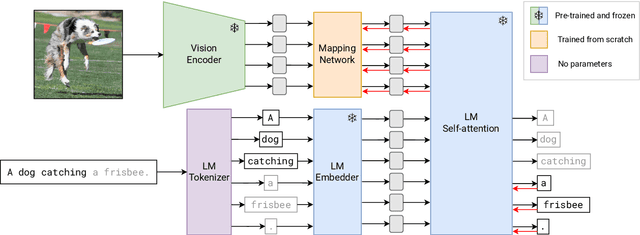

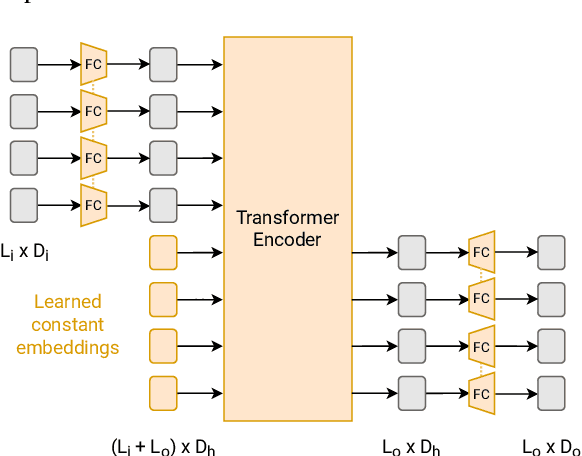
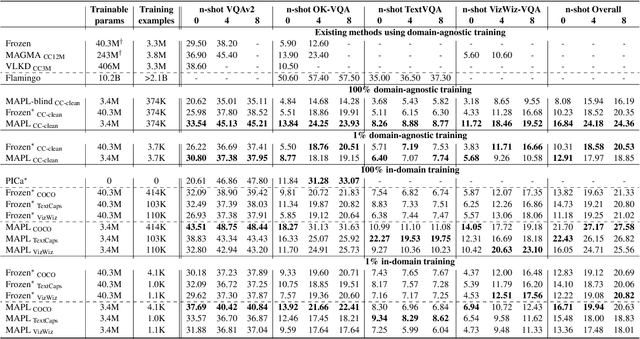
Abstract:Large pre-trained models have proved to be remarkable zero- and (prompt-based) few-shot learners in unimodal vision and language tasks. We propose MAPL, a simple and parameter-efficient method that reuses frozen pre-trained unimodal models and leverages their strong generalization capabilities in multimodal vision-language (VL) settings. MAPL learns a lightweight mapping between the representation spaces of unimodal models using aligned image-text data, and can generalize to unseen VL tasks from just a few in-context examples. The small number of trainable parameters makes MAPL effective at low-data and in-domain learning. Moreover, MAPL's modularity enables easy extension to other pre-trained models. Extensive experiments on several visual question answering and image captioning benchmarks show that MAPL achieves superior or competitive performance compared to similar methods while training orders of magnitude fewer parameters. MAPL can be trained in just a few hours using modest computational resources and public datasets. We plan to release the code and pre-trained models.
Rethinking Evaluation Practices in Visual Question Answering: A Case Study on Out-of-Distribution Generalization
May 24, 2022



Abstract:Vision-and-language (V&L) models pretrained on large-scale multimodal data have demonstrated strong performance on various tasks such as image captioning and visual question answering (VQA). The quality of such models is commonly assessed by measuring their performance on unseen data that typically comes from the same distribution as the training data. However, we observe that these models exhibit poor out-of-distribution (OOD) generalization on the task of VQA. To better understand the underlying causes of poor generalization, we comprehensively investigate performance of two pretrained V&L models under different settings (i.e. classification and open-ended text generation) by conducting cross-dataset evaluations. We find that these models tend to learn to solve the benchmark, rather than learning the high-level skills required by the VQA task. We also argue that in most cases generative models are less susceptible to shifts in data distribution, while frequently performing better on our tested benchmarks. Moreover, we find that multimodal pretraining improves OOD performance in most settings. Finally, we revisit assumptions underlying the use of automatic VQA evaluation metrics, and empirically show that their stringent nature repeatedly penalizes models for correct responses.
 Add to Chrome
Add to Chrome Add to Firefox
Add to Firefox Add to Edge
Add to Edge